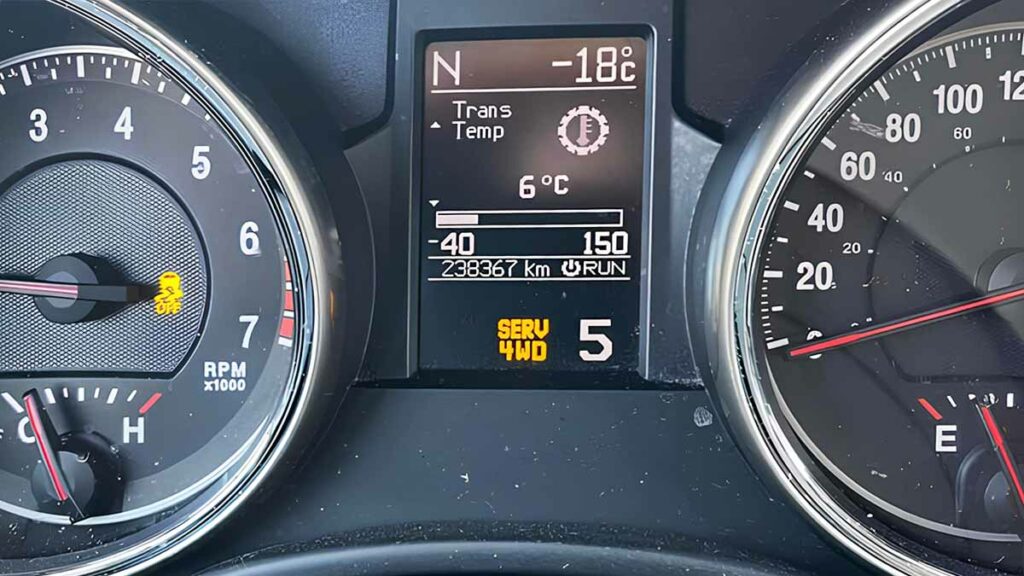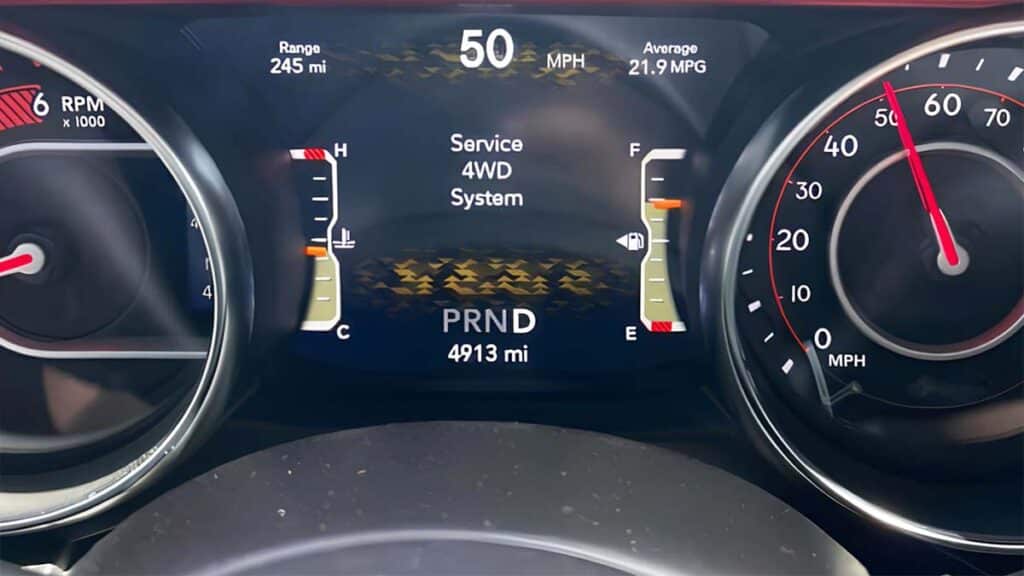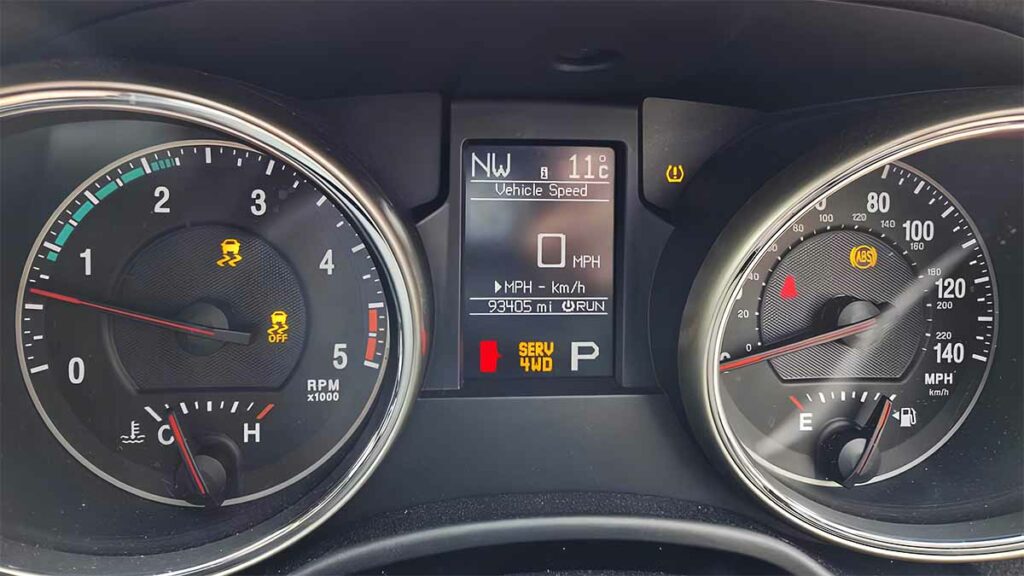How Do You Fix the Service 4WD Light on Your Jeep? (Solved)
Jeeps, known for their powerful engines and off-road capabilities, often come with a 4WD drivetrain. While Jeeps are generally reliable, issues like the Service 4WD light can still arise.
The Service 4WD light in your Jeep can be triggered by various issues, including a bad battery, faulty sensors and switches, a malfunctioning 4WD actuator, failing drive shafts, a faulty transfer case motor, a damaged 4WD control unit, worn-out parts, low fluid levels in the transfer case or differential, a malfunctioning transfer case and TCCM, and issues with the 4WD control module.

In this article, I’ll explain the significance of the Service 4WD light, decoding what triggers this warning, and how you can handle the situation.
Table of Contents
What Does Service 4WD Light Mean?
The SERV 4WD or SVC 4WD light is your vehicle’s way of telling you there may be an issue. Some of the Jeep models also show a Service Four Wheel Drive System warning on the dashboard with the SERV 4WD light.
Any warning light on your dashboard can cause concern, and the Service 4WD light is no exception.
This light signals an issue with your 4WD system, which is crucial to your vehicle’s performance and safety on the road. Ignoring it can eventually result in more serious issues.
One common reason this light illuminates is an incomplete gear shift. Switching from 2WD to 4WD while the vehicle is in motion can cause damage and trigger continuous flashing of the 4WD service light.
The flashing of the 4WD service light instead of a steady glow indicates an issue with the gear-shifting process. Recognizing the pattern of the alarm lights can help you identify the cause more efficiently.
If the light persists despite proper shifting, it’s time to consult a professional mechanic, which can indicate a potential transmission issue.
Sometimes, the flashing of the 4WD light may result from a system malfunction, possibly related to the vehicle’s internal computer.
Jeep manufacturers designed the Service 4WD light to ensure your drives are smoother and safer. When illuminated, it indicates that one or more components of the 4WD system may be malfunctioning.
The light serves as a reminder to address the issues promptly, preventing potential risks and ensuring a trouble-free ride.
Here’s the Corrected Version:
What Causes the Service 4WD Light to Come On? How Do You Fix It?
The Service 4WD light can come on due to various issues within your vehicle’s 4WD system. Here are some common reasons:
Bad Battery or Alternator
If you’re scratching your head over the Service 4WD System warning in your Jeep, consider looking into your battery and alternator.
Surprisingly, a bad battery or alternator can mess with the voltage, leading your Jeep to throw up false codes, including the bothersome Serv 4WD.
Start by checking your battery – make sure it’s not on the verge of dying, and inspect the terminals for any corrosion.
A weak or faulty battery can cause voltage instability, triggering misleading error codes. Remember that the alternator, not the battery, powers your vehicle’s electrical systems. Therefore, any voltage issues with the alternator can have a ripple effect on various Jeep components.
Why focus on the battery first? Well, a bad battery can cause a range of problems beyond just triggering the Service 4 WD light.
It may lead to difficulties starting your Jeep, erratic electrical issues, and even affect the proper functioning of sensors and computer systems.
So, before diving into complex diagnostics, check your battery thoroughly. Ensure it’s in good health, and the terminals are clean.
If you spot any issues, addressing them promptly may clear the false codes and prevent other electrical gremlins from creeping into your Jeep’s systems.
Defective Fuse
If you’re facing the dreaded Service 4WD light issue in your Jeep, one quick fix is checking and addressing a potentially defective fuse.
Before diving into other components related to the 4WD System Unavailable Service Required warning, I advise you to thoroughly inspect the fuse.
The 4WD service fuses can sometimes become blown or damaged, leading to malfunctions in your Jeep’s 4WD system and triggering the warning light.
Fuses play a crucial role in supplying power to the 4WD system, and if they’re loose or faulty, they may fail to maintain a consistent flow of power needed for the system to function correctly.
Even if there’s nothing inherently wrong with your Jeep’s four-wheeler system, a defective fuse can cause the SERV 4WD light to blink.
If you discover a damaged or blown fuse affecting the 4WD system, replace its key to get your Jeep back to normal operation and make that Service 4WD System warning disappear.
It’s essential to recognize that different Jeep models may have different fuses responsible for the Serv 4WD Light.
For instance, the culprits can be the Final Drive Control Module (FDCM) or Electronic Differential Lock (EDIFF) fuses in a Jeep Grand Cherokee.
Check your car’s manual to locate the specific fuses related to the four-wheel-drive system, unplug and plug them in tightly to address any loose connections, and replace any blown fuses as needed.
This simple check on your fuses may solve your Service 4WD light woes.

Fault Codes
If your Jeep’s 4WD system encounters issues, it may trigger fault codes stored in the Transfer Case Control Module (TCCM). Common fault codes related to the TCCM or 4WD system in Jeep vehicles include:
| Fault Code | Description |
| P0700 | Transmission Control System Malfunction |
| P0500 | Vehicle Speed Sensor Malfunction |
| P181x | Transfer Case Range Sensor Circuit Malfunction |
| P186x | Transfer Case Control Module (TCCM) Circuit Malfunction |
| P188x | 4WD Control Solenoid Circuit Malfunction |
| C1141 | Transfer Case Shift Motor Circuit Range Sensor Performance |
| C1160 | Transfer Case Shift Motor Circuit |
Using a diagnostic scanner, you can read and resolve these fault codes in the order they appear. Once the codes are addressed, test the control module.
Malfunctioning Front and Rear Axle
If your car’s Service 4WD light is flashing, the likely culprit is issues with the differentials, specifically the front and rear axles.
Malfunctions in these components can trigger the SERV 4WD light and lead to abnormal tire wear, noise, vibrations, and handling problems.
A common issue is rear differential leaking, which can manifest as a rattling noise when activating the 4WD system.
To address this, visually inspect the axles for wear and tear or any visible damage. Replace worn or damaged parts, such as CV joints, bearings, and seals.
Remember that replacing axles can be complex, so seek professional help if unsure. A single axle replacement can range from $300 to $1500, depending on the extent of damage and local labor costs.
Electrical System Problems
Damaged or corroded wiring within the 4WD system can commonly cause the Service 4WD light to be off.
Wiring is the vehicle’s nervous system, transmitting electrical signals between components. If wires are damaged, corroded, or broken, the 4WD system may malfunction, leading to the illumination of the service light.
Additionally, various components, such as the wiring harness, sensors, or switches related to the 4WD system, can experience glitches or failures.
Any malfunction in these components may cause the system to operate erratically or trigger the Service 4WD light.
In cases where fault codes like P1867, P1875, P1860, or P1887 are present, it indicates potential electrical circuit problems within the 4WD system. Addressing these electrical issues is crucial to ensure the proper functioning of your Jeep’s 4WD system and prevent further complications.
Use a diagnostic scanner or consult a qualified mechanic to identify and resolve specific electrical issues affecting your Jeep’s 4WD system.
For more information, check this TSB.
Faulty Sensors and Switches
If the sensors in your Jeep start malfunctioning, it can lead to inaccurate readings of wheel speeds or a need for revisions in the information from all four wheels.
When the 4WD system doesn’t receive precise information from the speed sensor, it triggers the SVC 4WD light. This issue can also extend to the transmission speed.
One critical sensor is the wheel speed sensor, which ensures proper wheel rotation. If this sensor fails to detect wheel speed due to electrical or internal damage, the Service 4WD light will blink.
Moreover, a faulty wheel speed sensor can impact the braking system, signaling the 4WD light to appear on the dashboard as a warning while driving.
The 4WD system relies on various other sensors, including the transmission speed and throttle position sensors. The wheel speed sensor assists the anti-lock braking system (ABS) by detecting wheel speed to prevent skidding.
Simultaneously, the transmission speed sensor measures the speed of transmission shafts, while the throttle position sensor regulates air intake for engine power.

If any of these sensors malfunctions or sends abnormal readings, the Service 4WD System warning message will flash. Common reasons for sensor damage include corrosion and exposure to the elements.
If you suspect a faulty sensor, troubleshoot the specific sensor causing issues. Once confirmed, replace the sensor promptly. You can replace the wheel speed sensor independently or seek professional assistance.
For transfer case switch or position sensor malfunctions, causing your vehicle to get stuck in one mode and triggering the Service 4WD warning light, address the issue promptly. A faulty actuator switch can also lead to problems engaging or disengaging the 4WD.
Faulty 4WD Actuator
If you’re having trouble engaging or disengaging your Jeep’s 4WD mode, the culprit can be a faulty 4WD actuator.
This component plays a crucial role in ensuring the proper functioning of the 4WD system, allowing seamless gear alignment when switching to 4WD mode.
The actuator’s primary job is to align the gears, facilitating the smooth engagement or disengagement of the four-wheel drive services in coordination with your Jeep’s operations. Unfortunately, if the actuator breaks down or becomes defective, it can lead to issues with gear alignment during 4WD mode switching. This difficulty is a clear indication of a malfunctioning 4WD system.
When faced with such issues, it’s essential to address them by restoring or replacing the faulty actuator.
Doing so ensures that the gear switching aligns correctly with the 4WD mode, allowing for a trouble-free and effective operation of your Jeep’s 4WD system.
Failing Drive Shafts
Ensuring your Jeep’s 4WD system works seamlessly relies heavily on having properly functioning drive shafts.
When these essential components become faulty, the engine’s power delivery to the wheels diminishes or ceases altogether, triggering the Service 4WD light.
Drive shafts may sometimes break or sustain damage, causing the Service 4WD light to illuminate. Drive shafts are critical in facilitating power transfer from the engine to the wheels.
When these shafts encounter faults or troubles, it results in a significant reduction or complete absence of power transmitted from the engine to your Jeep’s wheels.
If you notice the Service 4WD light coming on, mainly when the drive shafts are compromised, it signifies a crucial problem that needs attention.
To address this issue, carefully inspect the drive shafts, attempting repairs where feasible. However, if the chances of successful repairs are slim, opting for a replacement becomes necessary to prevent further complications and avoid continuous warning light alerts.
Faulty Transfer Case Motor
The transfer case in your Jeep is crucial in distributing power from the transmission to all four wheels through the front and rear driveshafts.
If you engage in excessive off-road driving, the transfer case may suffer damage to its motor or overheat due to excessive slack.
A loose shift lever can also contribute to these issues, resulting in uneven or reduced power delivery to the wheels and triggering the Service 4WD light.
When faced with such a malfunction, it’s essential to inspect the transfer case motor promptly. Look for signs of overheating or damage, and immediately repair or replace the transfer case motor.
Overheating or damaging the transfer case motor is a common culprit behind the SERV 4WD warning light. This motor transmits power to the axles and facilitates gear shifting.
The housing of the transfer case is typically made of soft magnesium metal, making it susceptible to damage. Bearings, gaskets, and internal components are also prone to wear and tear, especially under excessive heat.
Addressing this issue is critical, given the vital role of the transfer case in the 4WD system. Repairing a damaged motor is often complex, making replacement the most effective solution.
Visit your local automotive technician to have the transfer case motor replaced. Swift action ensures the continued functionality of your 4WD system and prevents potential safety hazards associated with compromised power distribution.
Damaged 4WD Control Unit
The control unit responsible for operating your Jeep’s 4WD system is often behind the rear bumper, a spot vulnerable to water exposure. This placement poses a significant risk, mainly when your car encounters water elements off-road.
A mere encounter with a deep puddle can elevate the risk of water damage to the 4WD control unit. Even minor splashes can render the module inoperable, necessitating the installation of a new one.
When the 4WD control unit succumbs to water damage, it deactivates the 4WD system. Until you replace the unit, your Jeep will be limited to front-wheel drive functionality. However, suppose the module fails unexpectedly in a remote location. In that case, you may find yourself grappling with the challenge of extricating your Jeep from challenging terrain without the assistance of a functional 4-wheel-drive system.
Regularly inspect the 4WD control unit for signs of water damage and take preventive measures, such as waterproofing or relocating the unit to a more secure location.
Being vigilant about potential water exposure can save you from the inconvenience of a non-functional 4WD system and its challenges, especially in off-road situations.
Worn Out Parts
In some vehicles, particularly older ones, a crucial part of the 4WD system is the locking hubs, which disconnect the front wheels from the front driveshaft.
On the other hand, modern cars use sophisticated electronics, like the anti-lock braking system (ABS), to control braking on skidding wheels.
Damage to either of these components can be a culprit behind the dreaded Service 4WD message.
For instance, locking hubs are prone to damage due to the accumulation of mud and rust. The ABS may malfunction if metal shavings reach the magnet wheel sensors, typically from equipment like an on-car lathe for resurfacing brake discs.
The differential axles are another critical component in the 4WD system, allowing wheels to rotate at different speeds.
Even damage to one of these axles can jeopardize the entire system. Avoiding mud and water is crucial to prevent potential damage, especially to the vent tube of the axle, which can draw in water, leading to a failing differential.
If you encounter the 4WD System Unavailable Service Required message, inspecting these components for wear and tear is essential.
Regular maintenance, cleaning, and avoiding challenging conditions like excessive mud or water can significantly prevent premature wear and ensure the longevity of these critical 4WD system parts.
Low Transfer Case or Differential Fluid Levels
Driving your Jeep in four-wheel-drive mode can consume more fuel, and issues related to low fuel levels or contaminated fuel may occasionally trigger the Service 4WD message.
If you encounter this, a simple solution is to refill your gas tank, as low fuel levels can contribute to the code.
However, the Service 4WD light can be a result of various issues. While your Jeep doesn’t have fluid level sensors in the differential, the control unit can detect signs of system malfunction.
Poor rotation, stuck gears, tension, or overheating may trigger the SVC 4WD light. In some cases, a slipping differential may immediately illuminate the warning light.
Inevitable mechanical failures, especially those related to the differential, may go unnoticed, and driving with a grinding noise may lead to significant repair costs.
Regular maintenance is crucial, including changing the differential and transfer case gear oil when necessary. Checking the fluid levels in these components halfway until the scheduled change is a proactive measure to ensure the proper functioning of your 4WD system.
Malfunctioning Transfer Case and TCCM
Your Jeep’s transfer case is a critical component that takes power from the engine and distributes it to the front and rear wheel sets.
If the transfer case overheats due to low fluid levels, it may struggle to transfer power effectively between the front and rear axles, leading to 4WD engagement or disengagement issues.
An aged or overheated transfer case loses its ability to maintain power distribution effectively. As a result, you may experience difficulty setting the gear stick at different positions, and the vehicle won’t accelerate with the engine.
These performance issues trigger the appearance of the 4WD light, warning you about potential risks.
Excessive off-road driving or too much slack in the transfer case can damage it, causing overheating or a loose shift lever. This, in turn, leads to a malfunctioning shift motor and unequal power distribution to the wheels, resulting in the 4WD service light coming on.
The Transfer Case Control Module (TCCM) may be the culprit if you’ve ruled out battery and electrical connector issues. This module operates the transfer case and monitors different sensors and switches in the 4×4 system.
To address this, inspect the transfer case. Examine the fuse box for any blown fuses related to the 4WD system and TCCM, replacing them with fuses of the same amperage. Inspect the wiring and connectors.
System Is Fine
Sometimes, when the Service 4WD light flashes, it doesn’t necessarily mean your car has a problem.
In fact, the system may be working perfectly fine. This light can illuminate when your vehicle lacks traction, especially on slippery surfaces or challenging terrains.
There are instances where the 4WD light may flash without any apparent reason.
In such cases, it can be a defect in the light itself rather than an issue with the 4WD system. Even if your engine is making a rattling noise, the 4WD light may still appear, but it doesn’t necessarily indicate a problem with the system.
However, it’s essential to note that having all four wheels in good condition is crucial for maintaining a grip on slippery surfaces like mud or ice. Without proper traction on all wheels, there’s a chance of losing control.
So, when you see the Service 4WD light, it’s not a guaranteed sign of actual problems with the 4WD system. It can indicate that the system may not be available then, and your vehicle can still operate fine.

How Do You Reset the Service 4WD Light?
If you’re dealing with a flashing 4WD light on your Jeep, resetting the Service 4WD light can be a solution. Here’s a step-by-step guide:
Step 1: Deactivate 4WD and Turn off the Engine
Begin by deactivating the 4WD system before shifting to reverse. Slow down your vehicle, set it to 4 HIGH on the transfer case lever, then put it in reverse and switch the transfer case to 2 HIGH. Turn off your Jeep’s engine.
Step 2: Take off the Fuse
Locate the fuse box. Find the ‘FDCM EDIFF’ fuse in the fuse box (refer to the diagram on the inner side of the cover). Remove the fuse. Ensure all other fuses are correctly seated.
Step 3: Start the Engine
Start the vehicle and drive back and forth for a short distance. Stop the car and place the fuse back in its original position after a few minutes. If the fuse looks damaged, replace it. Engage the vehicle to see if the 4WD light persists.
Can You Still Drive With the Service 4WD Light On?
If you find the Service 4WD light illuminated in your vehicle, you may wonder if it is okay to drive with the Service 4WD light on. Well, I advise you not to continue driving with it. Although the car may still move, doing so can lead to transmission issues and potential damage to the all-wheel drive system.
I strongly recommend taking your vehicle to a mechanic as soon as possible to diagnose and address the issue.
Driving with the Service 4WD light on is not recommended due to decreased traction, increased tire wear, and slower emergency response times. It’s crucial to prioritize getting your Jeep fixed to avoid further complications.
Also Read: Why Is My Jeep Check Engine Light Flashing? (13 Major Causes And Their Fixes)
Final Words
The Service 4WD light in your Jeep tells you something. This warning suggests there may be an issue with your 4WD system. You need to understand what it means and how to address it.
The Service 4WD light or Service Four Wheel Drive System warning on your Jeep dashboard may indicate problems such as faulty sensors, damaged components (e.g., wheel speed sensors, transfer case motors, and locking hubs), low fluid levels in the transfer case or differential, electronic malfunctions, and worn-out parts.
Ignoring this warning or neglecting regular maintenance can compromise your vehicle’s safety, traction, and stability, potentially resulting in costly repairs. Address the underlying issues promptly by seeking professional assistance and maintaining your Jeep regularly.
